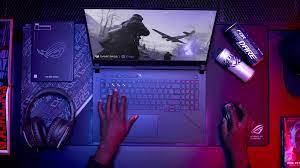Innovative gaming laptops are designed specifically for a seamless gaming experience. Ultra-modern gaming laptops will never provide the performance of gaming desktops of a similar price range. These systems need to be optimized for gaming for improved performance.
Compared to desktop computers, laptops have fewer upgrade options. In this post, you’ll explore some of the ways you can play your favorite game on your laptop with improved performance.
Choose the Right Surface
When you play for a long time, you might wish to play while relaxing on a bed or sofa. You might want to play by keeping your laptop on a couch or a bed. However, it can affect your gaming performance by making it slower and affecting the device’s health.
Putting the laptop on a soft surface may cause blocking in the vents of computers. It can cause overheating within the device because the generated heat can’t come out of the system. So, play games on the right surface avoiding soft and irregular surfaces.
Close Unnecessary Apps & Tabs
Unwanted apps running in the background and Chrome tabs can increase the RAM consumption and usage of other resources. So, if the games you are playing require more RAM than what is available in your system, close some or all of them.
When you close unnecessary tabs in Chrome or extensions, it can help reduce the RAM amount being used. Before you start any game, close other apps. However, if you want to reopen these tabs later.
Clean Your Laptop Regularly
People with no technical skills can improve gaming performance on their laptops by keeping their systems clean. Dust and dirt can reduce airflow and cause overheating. This can eventually slow down the performance of GPU, processor, and other components.
To make your laptop an effective gaming machine, keep it clean. But be careful while cleaning your laptop because it is sealed. Opening it on its own without any knowledge can void the warranty. Use appropriate cleaning techniques.
Improve Fan Speed
Most laptop gamers deal with the issue of heating. The latest laptops come with heat sinks, multiple fans, and various cooling technologies. These devices when not configured appropriately can lead to higher temperatures and affect gaming performance.
So, to improve gaming performance, ensure the temperature ranges from lower to moderate when playing games. Keep your fan working at maximum speed. Alternatively, turn on turbo boost to make sure the fan of the laptop hits maximum RPM (rotations per minute) and cool down.
Adjust Power Settings
Power management is important for enjoying gaming on laptops. So, check your power settings in Windows by clicking Start and then Settings. Or simply, enter WIN and I. Navigate to System and click Power and Sleep. Tap Additional power settings.
Choose High Performance and click Change Plan Settings. Tap advanced power settings. Make sure the power settings are applied to the optimum levels. Battery settings are managed automatically in some gaming laptops.
Disable Vsync in Games
Vsync is a feature that can decrease and resolve screen tearing issues. When this feature turns on, it can limit the maximum FPS (frames per second) while playing retro games. The main functionality of this feature is to lock the frame rate of a game to match the refresh rate of the display.
You will be unable to cross 60 FPS while gaming if Vsync remains turned on and the display is 60 hertz. The hardware can generate more than 100 FPS. This results in gameplay and input lagging. So, keep Vsync turned off unless you require using it.
Enable Windows Game Mode
Windows 10 and later versions have an Xbox app that consists of several features like streaming, Game Mode, and screen recording. Turning on the Game Bar and Game Mode can speed up gaming performance.
To turn on this mode, tap Start and then click Settings. Tap Gaming and hit Xbox Game Bar. Move to On IMAGE and choose Game Mode. Change to On and close to finish. Tap WIN and G to see the Xbox panel and checkmark the ‘Yes, this is a game’ box.
Hopefully, these effective ways will help you optimize your laptop gaming settings for Windows. Most of these tips can be simply implemented on Windows laptops, some can be used on Linux and macOS systems. Remember, you can’t upgrade the processor or graphics card in most laptops.
Installing new hardware like increasing the RAM and switching to a fast SSD like SATA or NVMe will improve gaming performance. Keep your battery upgraded to keep playing for any duration. You can also update Steam to make games run smoothly on a laptop.

